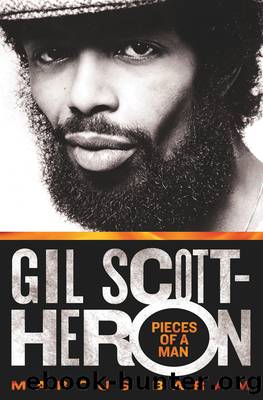Gil Scott-Heron--Pieces of a Man by Marcus Baram

Author:Marcus Baram
Language: eng
Format: epub
ISBN: 9781250012791
Publisher: St. Martin's Press
23.
“DO WE HAVE ENOUGH LOVE?”
Many of Gil’s early songs on Small Talk and Pieces of a Man focused on the oppression that he himself had experienced: racism in America. But by the mid-1970s, he started to expand his outlook, wielding his pen to write lyrics that addressed global issues such as the risks of nuclear power and environmental pollution, because he saw how those problems impacted people in poor neighborhoods. “A good poet feels what his community feels. Like if you stub your toe, the rest of your body hurts.”
Depending on his audience, Gil would adjust the tenor and content of his message. Before a huge crowd at the Rose Bowl, for example, he might express the militant revolutionary rhetoric of the late 1960s. Gil gave an illuminating interview in April 1976 to the Black Panther, the group’s eponymous newspaper, which captured his tendency to adjust his message to fit the audience. His comments were more militant than those he made to the mainstream media. At one point, he discouraged white activists from helping the black community, instead pushing them to raise hell in their own neighborhoods: “We say to white people, ‘Go revolutionary in your community ’cause it needs it. Do not come here, to help me deal with my community when your community is in such terrible shape.’” He also referred to the end of the Vietnam War as “how the Vietcong got free,” attributing much of that to the demonstrations in America. “And I’m saying that the pressure that was brought on the war mongers over here by the things that were happening domestically at the time they were bringing war down on them people, kept Nixon, at the height of Watergate, from going back in there and bombing those people again when they came down this spring and took their shit back, you see?”
Though Gil’s rhetoric could be fiery, he avoided some of the more extreme conspiracy theories that ricocheted around the community. Some in the dwindling ranks of black militants attributed their demise to a government plot to distract young Americans with newer movements, from women’s liberation to gay rights. But Gil deeply understood that all those liberation struggles were part of a continuum, that Russell Means’s American Indian movement had “a lot in common with Joan Little, who has a lot in common with Inez Garcia [a Hispanic rape victim who was put on trial for killing her assailant], who has a lot in common with the San Quentin Six [prisoners who were put on trial for killing guards during an escape attempt]—in terms of being symbols of how America had to change but did not.” They were all part of the same struggle, to make America the land of the free for all its citizens.
Though Gil was inspired by socialism, black nationalism, and pan-Africanism (movements and ideologies that coursed across college campuses and cities in that era), he maintained a certain independence of thought. He realized that even the most progressive organizations could become tyrannical and rigid in their rules.
Download
This site does not store any files on its server. We only index and link to content provided by other sites. Please contact the content providers to delete copyright contents if any and email us, we'll remove relevant links or contents immediately.
| Classical | Country & Folk |
| Heavy Metal | Jazz |
| Pop | Punk |
| Rap & Hip-Hop | Rhythm & Blues |
| Rock |
Cecilia; Or, Memoirs of an Heiress — Volume 3 by Fanny Burney(30958)
Cecilia; Or, Memoirs of an Heiress — Volume 2 by Fanny Burney(30915)
Fanny Burney by Claire Harman(25804)
We're Going to Need More Wine by Gabrielle Union(18096)
Plagued by Fire by Paul Hendrickson(16647)
Cat's cradle by Kurt Vonnegut(13914)
Bombshells: Glamour Girls of a Lifetime by Sullivan Steve(13129)
All the Missing Girls by Megan Miranda(12791)
Leonardo da Vinci by Walter Isaacson(11938)
4 3 2 1: A Novel by Paul Auster(11088)
Adultolescence by Gabbie Hanna(8160)
The remains of the day by Kazuo Ishiguro(7588)
Note to Self by Connor Franta(7035)
Diary of a Player by Brad Paisley(6872)
Giovanni's Room by James Baldwin(5910)
What Does This Button Do? by Bruce Dickinson(5541)
Recovery by Russell Brand(4576)
Born a Crime by Trevor Noah(4538)
The Kite Runner by Khaled Hosseini(4493)
